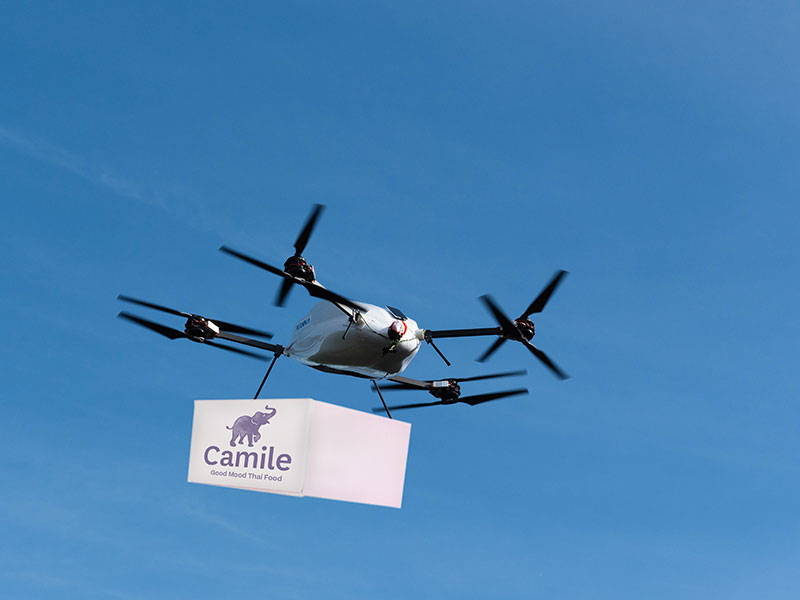After years of rumors and testing, the first non-beta drone deliveries of restaurant meals could take off this time next year through an ongoing partnership between Camile Thai and Manna, both based in Dublin, Ireland.

Brody Sweeney – director at Camile Thai
Brody Sweeney, director at Camile Thai, said his franchised fast-casual restaurant chain has rounded a corner with its ongoing drone deliveries in Ireland. If all goes according to plan, as the drone testing moves from a tiny village into a larger city, Camile expects to exit beta testing and begin at-scale drone operations in the fall of 2021.
So far, initial tests suggest drone deliveries will cost the restaurant about half of what it spends for car-based deliveries through its own in-house delivery fleet. With a maximum payload between four and five pounds, Camile expects to be able to send two of its main courses through the air directly to designated landing pads or customers’ own backyards.
Beyond the cost savings over automobile deliveries, Sweeney said Camile is “nutty” about reduced speed for consumers, as the drones can reach a speed of 50 miles per hour. In addition, he said the reduction in carbon footprint through more environmentally friendly drones is a major part of the appeal that’s pushed the Irish chain to the front of the horse race to become the first restaurant to roll out a large-scale drone delivery program.
“The technology works perfectly, Sweeney said of the ongoing tests in Ireland. With 35 units throughout the United Kingdom, and a recent focus on expanding in the greater London area, Camile said the company has experienced “all the highs and lows of the crack cocaine of the aggregators,” adding that the company found itself becoming addicted to that order stream and ended up feeling marginalized by third-party delivery services.
“On the other hand, it’s how people choose to shop, so I guess it’s up to us operators to figure out how to make it work, and ultimately the aggregators are going to have to figure it out,” too, Sweeney said. He said working with Just Eat, the company that is in the process of purchasing Chicago-based Grubhub, has proven to be a better business model for Camile, because “they don’t get involved in the physical delivery.”
For customers currently presented with the option of a drone delivery, they are sent a Google Earth satellite image of their property, broken into quadrants, where the customer can select which part of the yard or property the drone will deliver to. After a quick flight, ideally limited to just three or four miles, the drone then lowers the parcel down to the customer on a biodegradable line. Being able to bypass red lights and traffic, the company expects much quicker deliveries compared to car-based service, which should improve the economics of delivery, while resulting in happier customers.
Sweeney added that Manna expects to operate its drone deliveries through an “as a service” business model, where the restaurant would pay a monthly fee, but not be charged anything upfront.
Licensing has been the biggest issue during the pilot program, and current assumptions are that drones will need to file detailed flight plans to dedicate a six-foot-by-six-foot air corridor with the civil aviation authority. Compared to reports and leaks that suggest Amazon’s drone programs would use an actual manned operator for each aerial vehicle, Manna’s drones would be fully autonomous and would bypass any security concerns by not having onboard cameras.
For the restaurant, Camile expects using a shipping container-like building that is roughly the size of an average parking lot, where restaurant employees would load meals into the drone with a cassette device that has built in batteries, meaning each drone would have fresh batteries for each trip.
Sweeney said Manna recently passed the 20,000-delivery milestone, which has been conducted in a very small village to reduce any issues, like drones crashing or interference with other aspects of Irish daily life.
The onset of the COVID-19 pandemic delayed the latest testing phase, which temporarily switched to delivering prescription drugs to customers, rather than food or retail goods.
The current tests have been conducted with the premise that eventually large cities might have tens of thousands of drones operating overhead on any given day. Sweeney added that “a drone has to have the same safety standards as a 747, so it’s got to be perfect.”
Because drone deliveries will have limited ranges compared with most car-based deliveries, the company has changed its expansion strategy to include converting existing pubs with kitchen space suitable for Camile’s relatively simple menu.
Unless McDonald’s or Domino’s has a surprise drone program that’s tested, approved and ready to go, it’s likely that small-but-mighty Camile could be the first restaurant to cross the drone finish line. While avoiding power lines and drone-averse neighbors will always be a challenge, many industry watchers suggest that drones could dramatically bolster the economics of an industry that remains largely unprofitable.
“Everybody around the world is facing this same challenge,” Sweeney said. “Once it’s cracked, the rest will follow quickly.”




